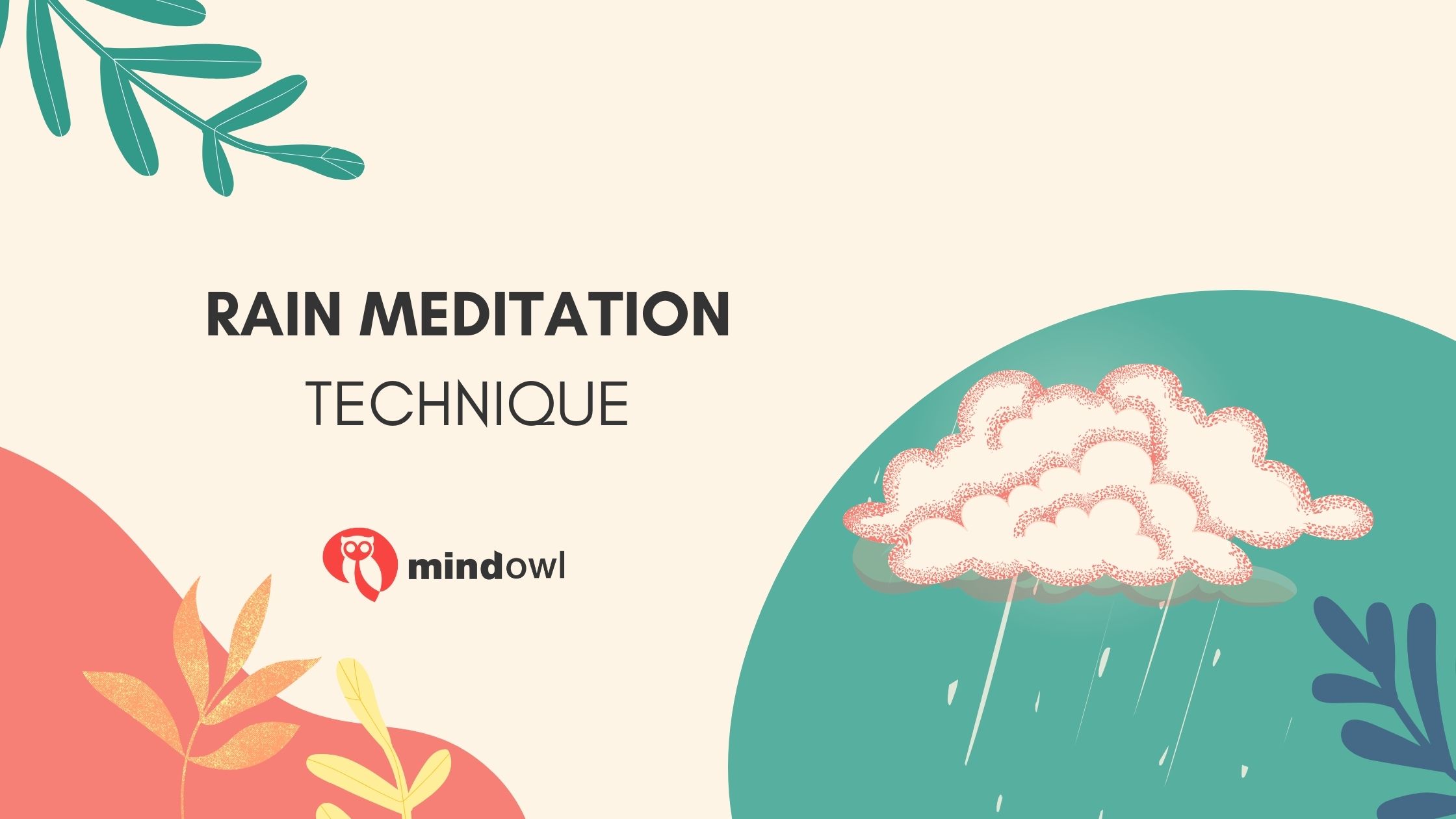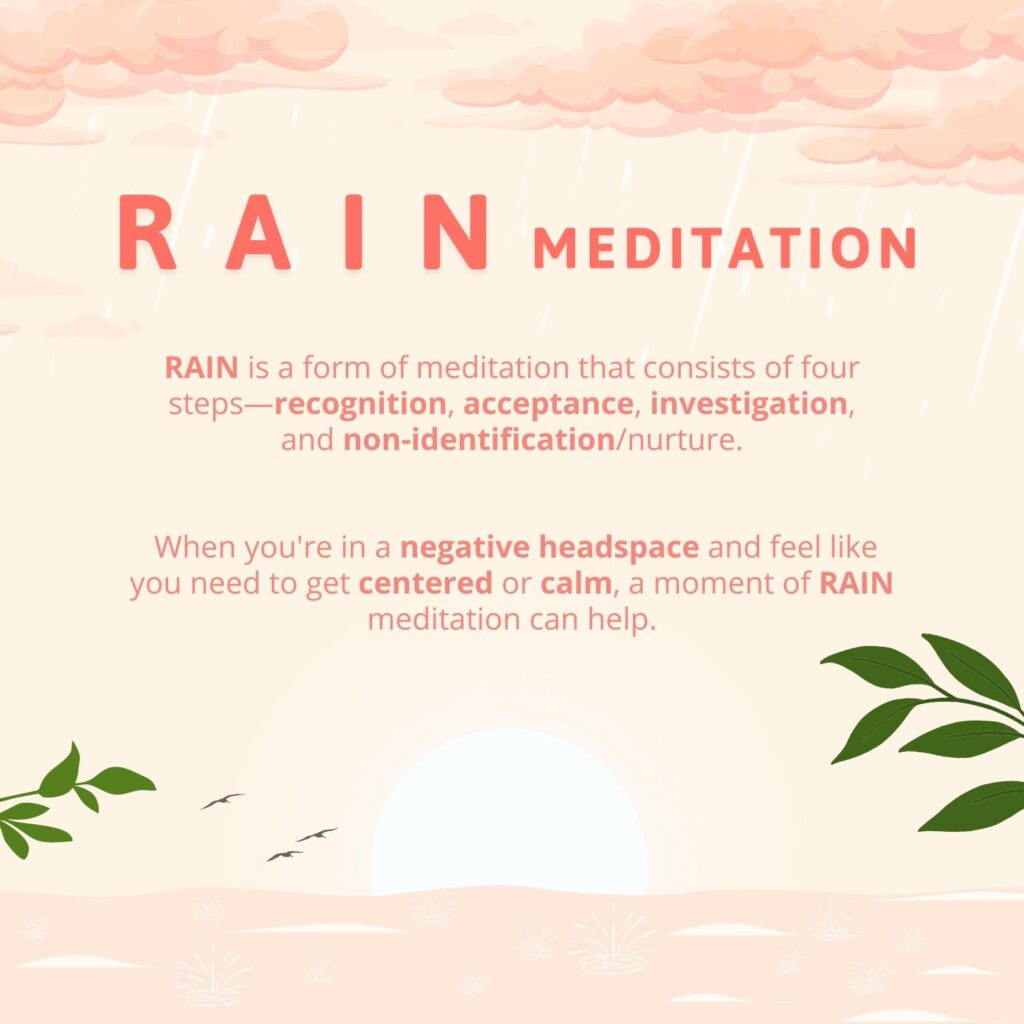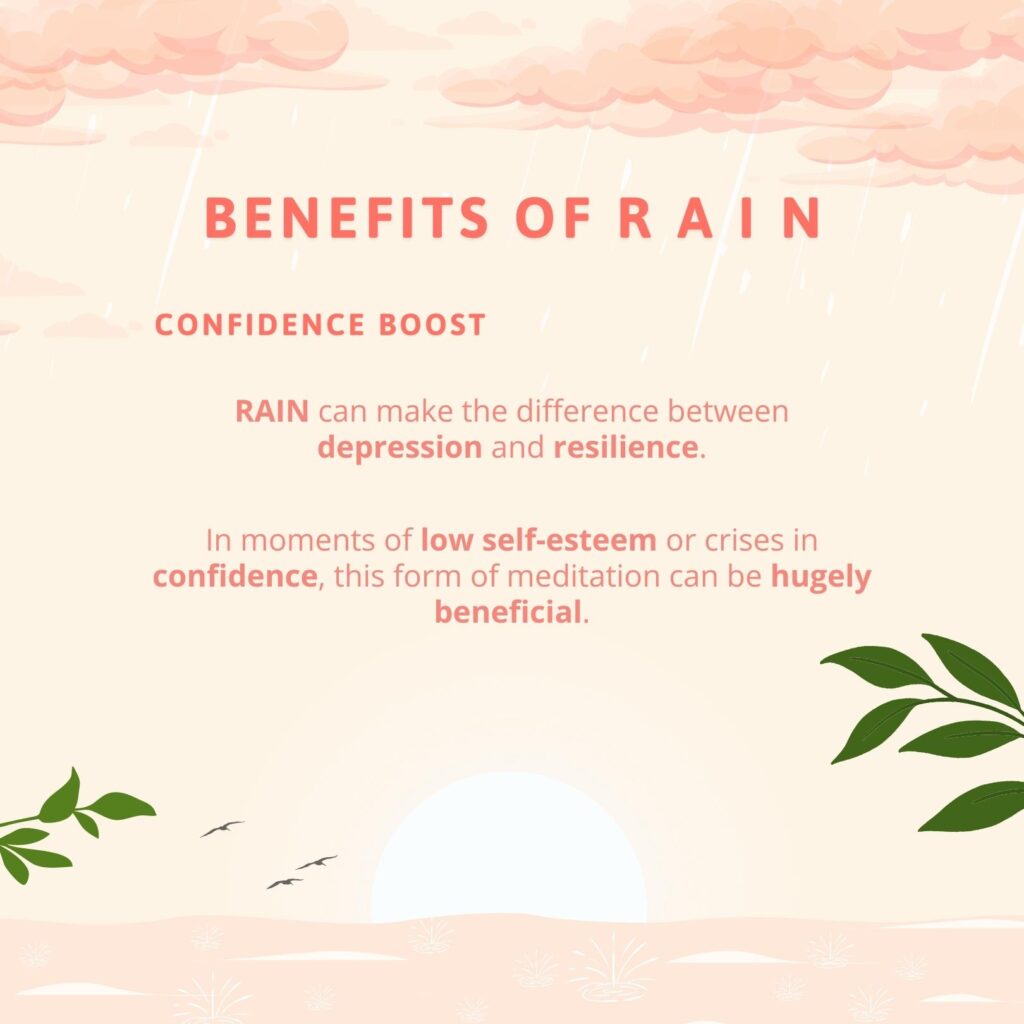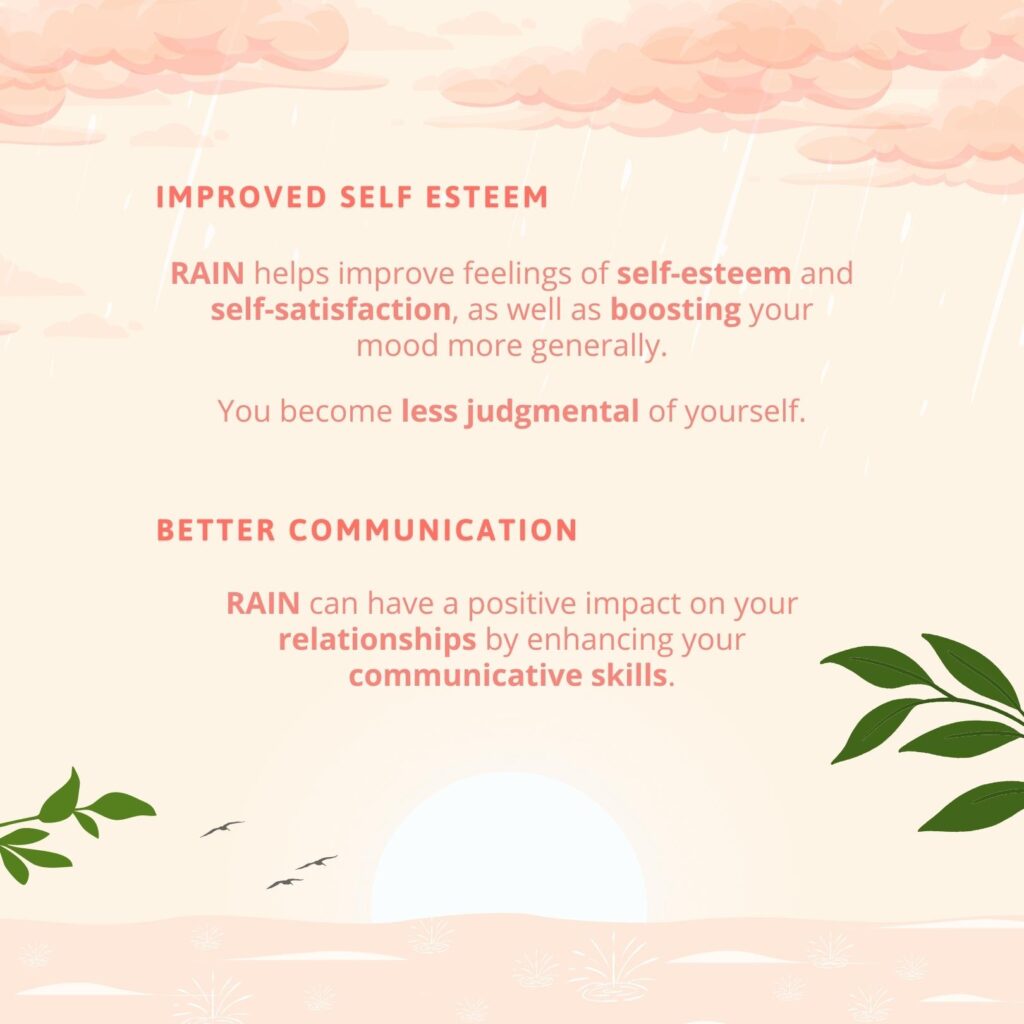Everyone experiences negative emotions from time to time — this is totally normal. However, when negative emotions persist and become overwhelming, they can start to affect your mental and physical health. Fortunately, there’s a simple meditation technique you can use to help you let go of negative emotions. This technique is called RAIN, and it can help alleviate anxiety, lessen the impact of negative feelings and reduce states of mind in which we feel unworthy or unwanted.
To be compassionate towards yourself, honesty is required. Direct contact with your vulnerability is also necessary. Mindfulness practice is about actively offering care to ourselves and therefore allowing compassion to fully blossom. The acronym RAIN refers to a specific technique within this broader spectrum, designed to help people deal with feelings of insecurity and unworthiness. In this article, we’ll dive into what RAIN Meditation is, and explore how it can help you to deal with moments of strong emotion and negativity. Let’s get started.
What is RAIN Meditation?
To understand what RAIN meditation is, it would be beneficial to first understand what meditation is more broadly. Meditation is a broad category of techniques that encourage a state of heightened awareness, often through focusing on the present moment. It has been found to have a number of potential mental and physical health benefits including lower blood pressure, reduced anxiety, and decreased physical pain. The meditation practice is taught by Buddhist teachers to help their students to achieve natural awareness and an awakened heart.
First coined around 20 years ago by Michele McDonald, RAIN is a form of meditation that consists of four steps—recognition, acceptance, investigation, and non-identification. Many psychologists have adapted and expanded on RAIN, including Tara Brach, the author of Radical Compassion. Within Tara Brach’s version of RAIN meditation, the N in RAIN stands for “nurture” rather than “non-identification”.
Soon, we’ll explore how you can practise RAIN yourself, and access its many benefits. But first, let’s consider what those benefits are…
Benefits of RAIN Meditation
RAIN meditation can have a number of positive effects. When you’re in a negative headspace and feel like you need to get centered, calm, or a little more confident, a moment of RAIN meditation can help. This could be in the form of a stand-alone meditation, or you could consider using DROP alongside it (this is a related technique which we’ll explore in more detail later).
Here are some of the main benefits of RAIN.
Confidence boost
RAIN makes the difference between depression and resilience for many people. In moments of low self-esteem or crises in confidence, this form of meditation can be hugely beneficial. According to Tara Brach, “During the Covid-19 pandemic, many people said that RAIN saved their life. In the moments of uncertainty, when they would just pause, let it be, and breathe with it for a little bit, RAIN increased the feelings of confidence that they can handle what was going on.”
Improved self-esteem
Rain helps improve feelings of self-esteem and self-satisfaction, as well as boosting your mood more generally. Most of us know that when we’re feeling down, we can become more inclined to be harsh on ourselves and escalate this period of suffering. Tara Brach says that RAIN can combat this by helping us “cultivate self-compassion and self-understanding, and when we have those things, we are much less judgmental especially of ourselves. RAIN can quieten our inner critic”.
Better communication
One of the biggest benefits of bringing mindfulness meditation into your life is that it can make you listen better, pay closer attention during conversations, and thus build greater connections with others. Just like mindful communication, RAIN can have a positive impact on your relationships by enhancing your communicative skills. If you are going to encounter someone or something you feel anger toward, calming down with RAIN can help you to engage in a more understanding and less blaming way.
How to practice RAIN
Now, it’s time to explain how RAIN works in practice. Essentially, it’s a pretty simple exercise. RAIN Meditation can be done on your own, or with guidance from a mindfulness teacher if you’d prefer. If you’re attempting to overcome trauma, the latter is probably more appropriate. Thankfully, whichever approach you choose, RAIN doesn’t require any special equipment, much like most other meditation techniques. Creator Michele McDonald suggests that “All we need is already inside us. We just have to access it.”
So how does it work? Let’s go through what a typical session looks like, with reference to Tara Brach’s RAIN meditation approach.
Set-Up
First, find a quiet place where you won’t be disturbed. Sit comfortably and relax. You don’t need to devote a whole lot of time to this meditation exercise; a short session with focused attention can be just as beneficial.
Recognise
Start to recognise what you’re feeling in the moment. “It’s a mental naming of what is going on,” says Tara Brach. Maybe you’re feeling anxious, or maybe you feel like you are drowning in sadness, rage, or other difficult emotions. Perhaps you recognize that strong emotions are getting in your way.
Accept
When we realise how we feel, it can be tempting to immediately act upon it. When we sense stress, we try to quickly solve the problem. However, this is often not the best approach. Instead, try to resist the urge to do this, and tell yourself “Don’t try to fix or judge it, let it be.” Embrace and welcome the feelings you’re experiencing, even if they’re uncomfortable.
Investigate
Alright, so you’re recognizing and accepting your feelings for what they are. Now, it’s time to go a step further. Take the time to get to know your feelings with interest and care. Mentally ask yourself some questions, like “What does it feel like?”, “How is your body reacting?”, and “How are these feelings affecting your thoughts?” At the same time, try not to sink into obsessive thinking.
Nurture
Remember, in Tara Brach’s iteration of RAIN, N stands for “nurture.” Offer the part of you that is distressed the things that it needs to feel comforted, once you’ve identified the source of certain problems. Nurture your mind and body until you feel soothed or the distress wanes.
Once you’ve completed the RAIN meditation process, take a moment to relax. Sense what has shifted or changed for you, and think about whether you feel more kindness or compassion, or less anger or fear.
RAIN in Daily Life
In the same way that mindfulness can be practised throughout the day, the RAIN acronym isn’t exclusively for formal meditation; it can be used in daily life too. When uncomfortable emotions or sensations arise, RAIN can help us deal with them in the moment, and stay connected to our inner experience rather than getting lost in reactivity or numbness. You can practice the RAIN method anytime you feel a difficult emotion arising, or you can use it in everyday life by checking in with yourself regularly.
Here are some good opportunities for using RAIN:
– When you feel triggered by something someone has said.
– When you notice you’re getting lost in rumination about the past or worrying about the future.
– If you find yourself zoning out or numbing out with food, TV, social media, or other activities.
– To connect with and comfort yourself when you’re feeling sad, scared, or angry.
In these moments, the practice of RAIN can help us focus by directing our attention in a clear and systematic way that cuts through the clutter and stress. This allows us to get back to ourselves when we’re feeling lost, and strengthens our ability to return to a place of balance and clarity.
Every time you practice RAIN, you strengthen your capacity to use it in more challenging situations. So, start with small annoyances or discomforts to get the hang of it. For example, the next time you’re stuck in traffic, use RAIN to deal with your frustration. Identify certain feelings throughout your day, and bring your attention to your habitual ways of responding.
Try to be flexible, too. You have a unique body and mind, with a particular history and conditioning. There is no one-size-fits-all approach to mindfulness or RAIN. Be patient with yourself and let the process unfold in its own time. If one strategy doesn’t work, try another.
When we have the courage to be with ourselves just as we are, a very powerful healing process occurs. We begin to connect with our own goodness, wisdom, and compassion — the best parts of ourselves that are always available but sometimes obscured by our difficult emotions.
Okay, let’s move on to discussing the DROP acronym.
A DROP of RAIN
Michelle McDonald recently added a new acronym to her RAIN formula. DROP is intended to reflect the idea that sometimes other feelings or thoughts get in the way when we are trying to be present. DROP stands for Delusion/Distraction, Resistance, Obliviousness, and Personalisation. Let’s explore those terms in some more depth.
Delusion/Distraction
If you’ve ever meditated, you probably understand how easily you and your mind can become distracted.
You may be trying to experience the recognition stage of RAIN, but your brain’s stuck on a thought from the morning. Don’t be disheartened — the truth is, we can’t always be present, and it’s useless trying to constantly force ourselves to be. When you notice these distracting thoughts, acknowledge that this is part of the process, and use your breath as an anchor for bringing yourself back to the present moment.
Resistance
The A in RAIN stands for acceptance of these emotions. However, your mind is likely to resist them. It can be difficult for you if you feel anxious or angry to allow yourself to feel that way. Overcome the resistance by pushing through the negative emotions.
Obliviousness
If we pretend that feelings aren’t there or that they aren’t having a certain impact on us, we are being oblivious, which isn’t healthy. The investigation step of RAIN can help us to understand how we are reacting, which allows us to let go of difficult thoughts and feelings. Obliviousness means sweeping feelings, emotions, and thoughts under the rug, which simply causes a long-term build-up of stress.
Personalisation
The “N” in RAIN stands for natural awareness, which is about not taking emotions and thoughts personally, and instead thinking of them as passing things which aren’t a reflection of your identity. Anger can exist, but it doesn’t have to be your anger. Instead, try to look at it in a more impersonal way. “If you let yourself be the possessor, you will hold onto it, but if you are mindful of it, the negative feeling passes by itself,” McDonald says. Cultivating natural awareness in this way is key to a healthier mind.
Make it RAIN
We all get lost in our own dense forest of anxiety, worry, and planning, entangled in incessant judgements of others, and busy trying to meet demands and solve our problems. When we‘re caught in that thick forest, it’s hard to see what really matters. We forget how much our hearts long for kindness and openness. Use a branch of meditation, let the RAIN pour in, and broaden your horizon of understanding your powerful emotions while building on gentle attention for yourself and your surroundings.
Why not give RAIN a try? All you will lose is a couple of minutes of your day (and maybe those heavy negative emotions you have on your shoulders). In return, you’ll improve your ability to engage with your moment-to-moment experience, shake out of the grip of fear and reduce the impact of difficult emotions.
If you want to find out some more game-changing techniques and ways of looking at the world, try out our completely free meditation taster course. In the course, we tackle a variety of exercises and methods proven to reduce stress and anxiety, improve peace of mind and enhance your sense of perception.
Frequently Asked Questions:
What are the 4 steps of rain?
The four steps of RAIN are:
- Recognise what is going on
- Accept the experience as it is
- Investigate with kindness and compassion
- Nurture what you find, give it the comfort it needs
Where did RAIN come from?
RAIN is a process that was developed as part of the mindfulness movement, which is characterized by an emphasis on maintaining awareness of your surroundings and the thoughts and feelings that accompany them without judgment. It was first developed around 20 years ago by Michele McDonald.
What is the Rain method for anxiety?
R.A.I.N. is there to remind you how to deal with challenging feelings like anxiety.
- Recognition – Notice your anxiety
- Acceptance – Accept that your anxiety is present
- Investigation – Investigate how you are reacting to your anxiety through your body or other emotions and thoughts
- Non-Identification – You are now aware but can let go of the feeling of anxiety
MindOwl Founder – My own struggles in life have led me to this path of understanding the human condition. I graduated with a bachelor’s degree in philosophy before completing a master’s degree in psychology at Regent’s University London. I then completed a postgraduate diploma in philosophical counselling before being trained in ACT (Acceptance and commitment therapy).
I’ve spent the last eight years studying the encounter of meditative practices with modern psychology.






